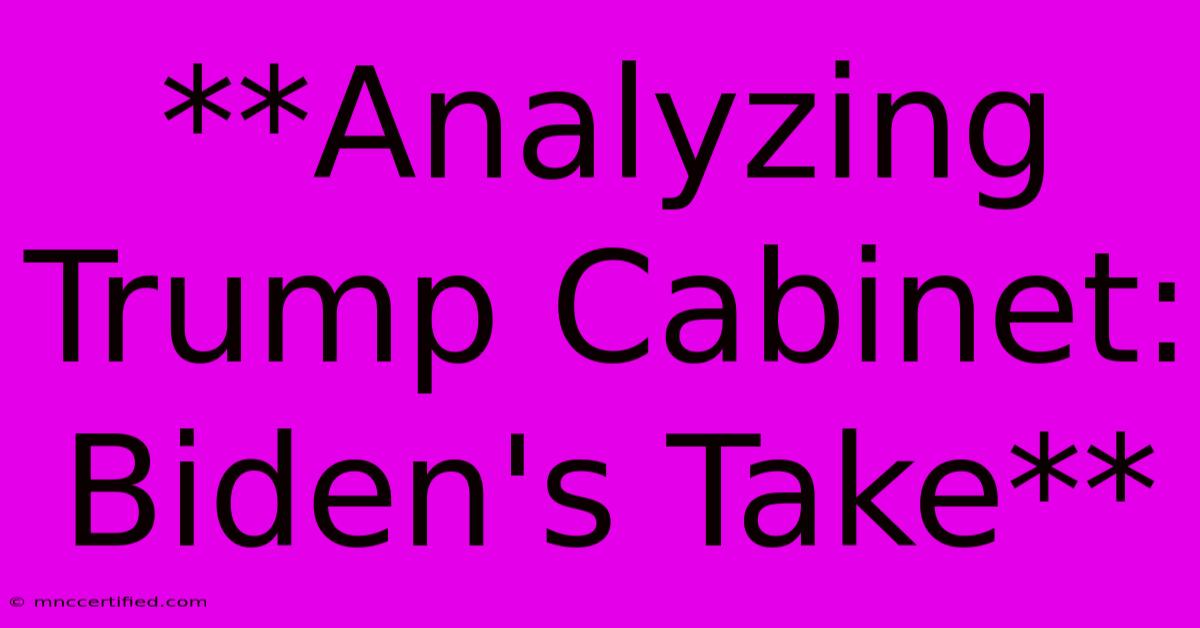**Analyzing Trump Cabinet: Biden's Take**

Table of Contents
Analyzing Trump Cabinet: Biden's Take
The transition of power from Donald Trump to Joe Biden marked a significant shift in American politics, and nowhere was this more evident than in the makeup of the presidential cabinet. Biden's cabinet choices reflected a clear departure from his predecessor's approach, prioritizing experience, diversity, and a commitment to restoring America's global leadership.
A Shift in Priorities
Trump's cabinet was largely composed of individuals with close ties to the business world and limited government experience. In contrast, Biden's selections emphasized expertise in policy areas and a dedication to public service. While Trump's cabinet was often criticized for its lack of diversity, Biden actively sought to build a cabinet that reflected the demographics of the nation.
Key Comparisons and Contrasts
Here's a comparative look at some key cabinet positions and the stark differences in approach between the two administrations:
State Department:
- Trump: Mike Pompeo, a former congressman and CIA director, focused on a transactional approach to foreign policy and a strong "America First" stance.
- Biden: Antony Blinken, a seasoned diplomat with extensive experience in foreign policy, prioritized rebuilding alliances and restoring America's role in international organizations.
Defense Department:
- Trump: Mark Esper, a former defense industry executive, favored a strong military presence and a hardline approach to national security.
- Biden: Lloyd Austin, a retired four-star general, focused on restoring military readiness, addressing climate change as a national security threat, and promoting diversity within the armed forces.
Treasury Department:
- Trump: Steven Mnuchin, a former investment banker, prioritized tax cuts and deregulation for businesses.
- Biden: Janet Yellen, a former Federal Reserve Chair, focused on economic recovery, addressing inequality, and tackling climate change through fiscal policy.
The Impact of Biden's Cabinet
The impact of Biden's cabinet choices is still unfolding, but it's clear that they represent a significant shift in the direction of the U.S. government. Here are some potential impacts:
- Re-engagement in International Affairs: Biden's commitment to rebuilding alliances and restoring America's leadership in international institutions is already evident in his administration's approach to global challenges like climate change and the COVID-19 pandemic.
- A Focus on Domestic Priorities: Biden's cabinet prioritizes addressing domestic issues like economic inequality, climate change, and healthcare, signaling a departure from Trump's focus on national security and border control.
- A More Inclusive Government: Biden's commitment to diversity and inclusion is reflected in the composition of his cabinet, which features a record number of women, people of color, and LGBTQ+ individuals.
Conclusion
The difference between Trump's and Biden's cabinets reflects a fundamental divergence in their visions for America's role in the world and their approach to governing. Biden's emphasis on experience, diversity, and a commitment to multilateralism marks a stark contrast to Trump's populist and nationalist approach. The long-term implications of these choices remain to be seen, but it is clear that the Biden administration is charting a new course for American policy.
Keywords: Trump Cabinet, Biden Cabinet, Antony Blinken, Lloyd Austin, Janet Yellen, Mike Pompeo, Mark Esper, Steven Mnuchin, foreign policy, domestic policy, diversity, leadership, America First, international affairs, multilateralism, national security, economic recovery, climate change, healthcare.

Thank you for visiting our website wich cover about **Analyzing Trump Cabinet: Biden's Take** . We hope the information provided has been useful to you. Feel free to contact us if you have any questions or need further assistance. See you next time and dont miss to bookmark.
Featured Posts
-
Floridas Gaetz Trumps Ag Nominee
Nov 14, 2024
-
Health Insurance Brokers Pittsburgh
Nov 14, 2024
-
Sri Lanka Dominant Mendis 143 Fernando 100 In Win
Nov 14, 2024
-
Megalopolis Streaming Find It Now Online
Nov 14, 2024
-
Pacific Star Insurance Phone Number
Nov 14, 2024